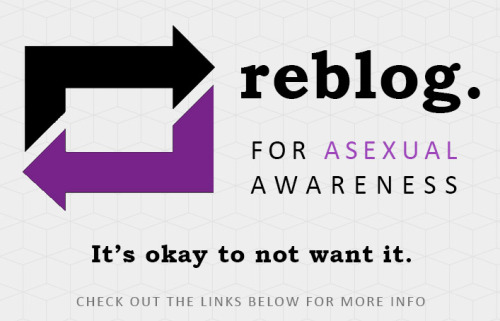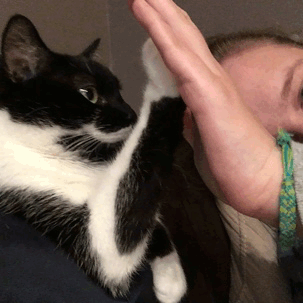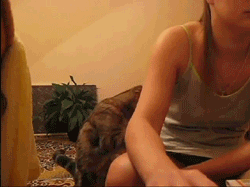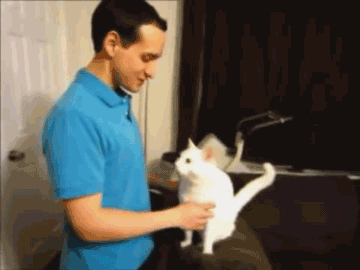Stephen Hawking’s Quote Speaks To The Heart Of Why Basic Income Has Become Such A Popular Idea In One








Stephen Hawking’s quote speaks to the heart of why basic income has become such a popular idea in one vital industry in recent years.
Follow @the-future-now
More Posts from Er-zico and Others

Asexuality is an orientation in which a person does not experience sexual attraction to any sex and/or gender. They do not feel an intrinsic desire to make sex a part of their relationships with other people. However they may still be able to experience other types of attraction, and desire relationships with other people.
Check out the following websites to learn more about asexuality, join in on the community, and/or help increase asexual visibility and education.
Asexual Visibility and Education Network
International Asexuality Conference (Worldpride Toronto 2014 Affiliate Event) (June 28, 2014)
Asexual Things (asexual vis/ed tumblr blog)
Frequently Asked Questions
Asexuality Websites/Blogs/etc










Teacher Draws Impressively Detailed Anatomical Illustrations on Classroom’s Chalkboard
Illustrator and anatomy instructor Chuan-Bin Chung composes stunning and highly detailed illustration of the human drawing. He creates the ephemeral drawings on chalkboards as a learning guide. He beautifully depicts the body’s muscles, bones and tendons.
Keep reading
Muslims, dalits and adivasis — three of the most vulnerable sections of Indian society — make up more than half of India’s prison population, according to an official report.
“Poverty is more prevalent among these three communities and that becomes an obstacle in dealing with the legal system,” said Colin Gonsalves, human rights activist and lawyer.
“Our system has an ingrained communal and casteist bias. Also, the proportion of these communities in the police officers and even judiciary is less. These are key factors behind this shocking imbalance,” he added.

Richard Feynman (above) included a poem in his address to the National Academy of Sciences:
I stand at the seashore, alone, and start to think.
There are the rushing waves mountains of molecules each stupidly minding its own business trillions apart yet forming white surf in unison Ages on ages before any eyes could see year after year thunderously pounding the shore as now. For whom, for what? On a dead planet with no life to entertain. Never at rest tortured by energy wasted prodigiously by the Sun poured into space. A mite makes the sea roar. Deep in the sea all molecules repeat the patterns of one another till complex new ones are formed. They make others like themselves and a new dance starts. Growing in size and complexity living things masses of atoms DNA, protein dancing a pattern ever more intricate. Out of the cradle onto dry land here it is standing: atoms with consciousness; matter with curiosity. Stands at the sea, wonders at wondering: I a universe of atoms an atom in the Universe.
Image source

Today’s #dalithistory month post is on the Adi-movements of the 1920’s and 30s. For Dalit history, ‘Adi’ ideologies are highly significant as they bear testament to some of our earliest assertion of equal rights, humanity and citizenship on level with other castes.
By the late 19th century, leaders like the social reformer Jyotirao Phule, had created a powerful anti-caste space, upholding non-Brahmanical thought and presenting the dream of a new egalitarian value system on which to model society on. Soon after, the early 20th century saw several archeological discoveries being made in Mohenjodaro and Harappa in the North, pointing to the existence of an unexpectedly ancient civilization that was likely much older than Aryan migrations. These discoveries struck a profound chord with Dalits all over the subcontinent, who immediately began to identify as an indigenous population who were conquered and subsequently oppressed by an alien religion. Although, the evidence for Aryan conquests remains contested, these interpretation was so compelling that such “Adi” (Ancient/Old/Original) movements sprung up all over the nation completely independently of each other.
The names of these movements are telling - Ad-Dharm in Punjab, Adi-Hindu in U.P. and Hyderabad, Adi-Dravida, Adi-Andhra and Adi-Karnataka in South India - all indicating a common claim to nativity and original inhabitation.
The provocative effects of the Adi-movements are best illustrated by an early Maharashtrian pre-Ambedkar Dalit leader, Kisan Faguji Bansode, who warned his caste-Hindu friends in 1909, stating: “The Aryans - your ancestors - conquered us and gave us unbearable harassment. At that time we were your conquest, you treated us worse than slaves and subjected us to any torture you wanted. But now we are no longer your subjects, we have no service relationship with you, we are not your slaves or serfs… We have had enough of the harassment and torture of the Hindus.”
In Andhra, the process was accelerated by the commercialized coastal areas that produced both a mobile Dalit agricultural class and a small educated section that produced leaders Bhagyareddy Varma and Arigyay Ramswamy who managed to mobilize nearly a third of the Malas and Madigas of the Madras Presidency to state their identity in the official census of 1931 as Adi-Andhra.
In Tamil Nadu, some Dalits identified themselves as Adi-Dravidas while Telugu and Kannada counterparts also identified as Adi-Hindu or Adi-Karnataka. In the north, in Uttar Pradesh, an untouchable ascetic, who radically called himself Acchutananda, began to organize an Adi-Hindu identity, arguing, “The untouchables, are in fact Adi-Hindu, i.e. the original and autochthonous Nagas or Dasas of the north and the Dravidas of the south, the undisputed, heavenly owners of Bharat.”
In Punjab, Mangoo Ram Mugowalia, a Dalit who had left the Gaddar movement, unable to stand the Casteism within it, began the Ad-Dharmi movement. By 1926, he had influenced a huge number of Dalits to boldly register themselves a separate “quaum” (religious group) in Hoshiarpur despite the threat of imminent violence. By the 1931 census, nearly 500,000 Dalits registered themselves as Ad-Dharmis all over Punjab.
To counter a growing ‘Adi’ consensus, Brahmins began actively renaming Dalits, ‘Panchama’ (the Fifth). Gandhi used it in his Young India for a long time. Many Dalits of the day strongly pushed back against the term insisting the idea of ‘Panchama’ was derogatory and only served to attenuate the age-long hyper-oppressive framework of Hindu society and solidify their position outside the caste order.










Nearly half a century after Roe, it’s time the media stops treating abortion like something taboo and start treating it like what it is – an important and normal part of life for a huge portion of Americans.



Better late than never! It’s time to start Icy Dwarf Planets Month with our favorite icy world, Pluto!
Besides, think of it as fun early Saturday morning cartoons!
http://space-facts.com/pluto/
10 Ways to Look After Your Mental Wellbeing (with added kitties)
1. Talk about your feelings
Talking about your feelings can help you stay in good mental health and deal with times when you feel troubled.

2. Keep active
Regular exercise can boost your self-esteem and can help you concentrate, sleep, and look and feel better. Exercise keeps the brain and your other vital organs healthy, and is also a significant benefit towards improving your mental health.

3. Eat well
Your brain needs a mix of nutrients in order to stay healthy and function well, just like the other organs in your body. A diet that’s good for your physical health is also good for your mental health.

4. Drink sensibly
We often drink alcohol to change our mood. Some people drink to deal with fear or loneliness, but the effect is only temporary.
When the drink wears off, you feel worse because of the way the alcohol has affected your brain and the rest of your body. Drinking is not a good way to manage difficult feelings.

5. Keep in touch
There’s nothing better than catching up with someone face to face, but that’s not always possible. You can also give them a call, drop them a note, or chat to them online instead. Keep the lines of communication open: it’s good for you!

6. Ask for help
None of us are superhuman. We all sometimes get tired or overwhelmed by how we feel or when things don’t go to plan.
If things are getting too much for you and you feel you can’t cope, ask for help. Your family or friends may be able to offer practical help or a listening ear.
Local services are there to help you.

7. Take a break
A change of scene or a change of pace is good for your mental health.
It could be a five-minute pause from cleaning your kitchen, a half-hour lunch break at work, or a weekend exploring somewhere new. A few minutes can be enough to de-stress you. Give yourself some ‘me time’.

8. Do something you’re good at
What do you love doing? What activities can you lose yourself in? What did you love doing in the past?
Enjoying yourself can help beat stress. Doing an activity you enjoy probably means you’re good at it, and achieving something boosts your self-esteem.

9. Accept who you are
We’re all different. It’s much healthier to accept that you’re unique than to wish you were more like someone else. Feeling good about yourself boosts your confidence to learn new skills, visit new places and make new friends. Good self-esteem helps you cope when life takes a difficult turn.

10. Care for others
‘Friends are really important… We help each other whenever we can, so it’s a two-way street, and supporting them uplifts me.’
Caring for others is often an important part of keeping up relationships with people close to you. It can even bring you closer together.

(Source: mentalhealth.org.uk)

The Migration of Anatomically Modern Humans
In paleoanthropology, the recent African origin of modern humans, frequently dubbed the “Out of Africa” theory, is the most widely accepted model describing the geographic origin and early migration of anatomically modern humans. The concept was speculative until the 1980s, when it was corroborated by a study of present-day mitochondrial DNA, combined with evidence based on physical anthropology of archaic specimens.
Genetic studies and fossil evidence show that archaic Homo sapiens evolved to anatomically modern humans solely in Africa, between 200,000 and 150,000 years ago, that members of one branch of Homo sapiens left Africa by between 125,000 and 60,000 years ago, and that over time these humans replaced earlier human populations such as Neanderthals and Homo erectus. The date of the earliest successful “out of Africa” migration (earliest migrants with living descendants) has generally been placed at 60,000 years ago as suggested by genetics, although migration out of the continent may have taken place as early as 125,000 years ago according to Arabian archaeology finds of tools in the region. Read More



A team of scientists has developed “robot flies” about the size of a quarter that can perch on almost any surface.
The perching works using static electricity. Each drone carries a tiny copper electrode on its head. When the electrode is energized, it creates a static charge that sticks the robot to a surface. Turning off the electrode sends the little drone back into the air.
Perching is important because it makes the robots more energy efficient. Perching is up to a thousand times more energy-efficient than hovering in place, the researchers say.
Read more about roboflies here.
-
 amimarinayet liked this · 1 year ago
amimarinayet liked this · 1 year ago -
 tresfoufou liked this · 3 years ago
tresfoufou liked this · 3 years ago -
 bentleysteed reblogged this · 4 years ago
bentleysteed reblogged this · 4 years ago -
 gradea87 reblogged this · 5 years ago
gradea87 reblogged this · 5 years ago -
 izoryotaro reblogged this · 5 years ago
izoryotaro reblogged this · 5 years ago -
 rem-cycle reblogged this · 5 years ago
rem-cycle reblogged this · 5 years ago -
 mskaylee liked this · 5 years ago
mskaylee liked this · 5 years ago -
 forestlich liked this · 5 years ago
forestlich liked this · 5 years ago -
 lusciouslusus reblogged this · 5 years ago
lusciouslusus reblogged this · 5 years ago -
 alliaskisthepossibilityoflove liked this · 5 years ago
alliaskisthepossibilityoflove liked this · 5 years ago -
 jenroses reblogged this · 5 years ago
jenroses reblogged this · 5 years ago -
 isisnocturne1369 reblogged this · 5 years ago
isisnocturne1369 reblogged this · 5 years ago -
 liliavem liked this · 5 years ago
liliavem liked this · 5 years ago -
 isisnocturne1369 reblogged this · 6 years ago
isisnocturne1369 reblogged this · 6 years ago -
 lanthir reblogged this · 6 years ago
lanthir reblogged this · 6 years ago -
 prevaricant liked this · 6 years ago
prevaricant liked this · 6 years ago -
 j-a-cobb liked this · 6 years ago
j-a-cobb liked this · 6 years ago -
 quann-fruts-malk liked this · 7 years ago
quann-fruts-malk liked this · 7 years ago -
 sideshogun-blog liked this · 7 years ago
sideshogun-blog liked this · 7 years ago -
 isisnocturne1369 reblogged this · 7 years ago
isisnocturne1369 reblogged this · 7 years ago -
 gradea87 reblogged this · 7 years ago
gradea87 reblogged this · 7 years ago -
 theredearth reblogged this · 7 years ago
theredearth reblogged this · 7 years ago -
 theredearth liked this · 7 years ago
theredearth liked this · 7 years ago -
 zeshuetoral reblogged this · 7 years ago
zeshuetoral reblogged this · 7 years ago -
 iammyfather reblogged this · 7 years ago
iammyfather reblogged this · 7 years ago -
 ennuinyx reblogged this · 7 years ago
ennuinyx reblogged this · 7 years ago -
 basicincomehive reblogged this · 7 years ago
basicincomehive reblogged this · 7 years ago -
 titaniumsansa liked this · 7 years ago
titaniumsansa liked this · 7 years ago -
 i-am-society reblogged this · 7 years ago
i-am-society reblogged this · 7 years ago -
 asirenbyanyothername liked this · 7 years ago
asirenbyanyothername liked this · 7 years ago -
 nquetzl liked this · 7 years ago
nquetzl liked this · 7 years ago -
 nquetzl reblogged this · 7 years ago
nquetzl reblogged this · 7 years ago -
 karafuto-chan reblogged this · 7 years ago
karafuto-chan reblogged this · 7 years ago -
 nin0309 reblogged this · 8 years ago
nin0309 reblogged this · 8 years ago -
 nin0309 liked this · 8 years ago
nin0309 liked this · 8 years ago -
 acatnamedoj reblogged this · 8 years ago
acatnamedoj reblogged this · 8 years ago -
 cupofjobe reblogged this · 8 years ago
cupofjobe reblogged this · 8 years ago
Dear Readers,Welcome to my personal blog. I'm Sabyasachi Naik (Zico,24).An Agnostic,deeply NON religious(atheist), and Secular Progressive Civil Engineer . I'm brown and proud to be an Indian tribe. “I want to say a word to the Brahmins: In the name of God, religion, sastras you have duped us. We were the ruling people. Stop this life of cheating us from this year. Give room for rationalism and humanism.” ― Periyar E.V. Ramasamy
198 posts
